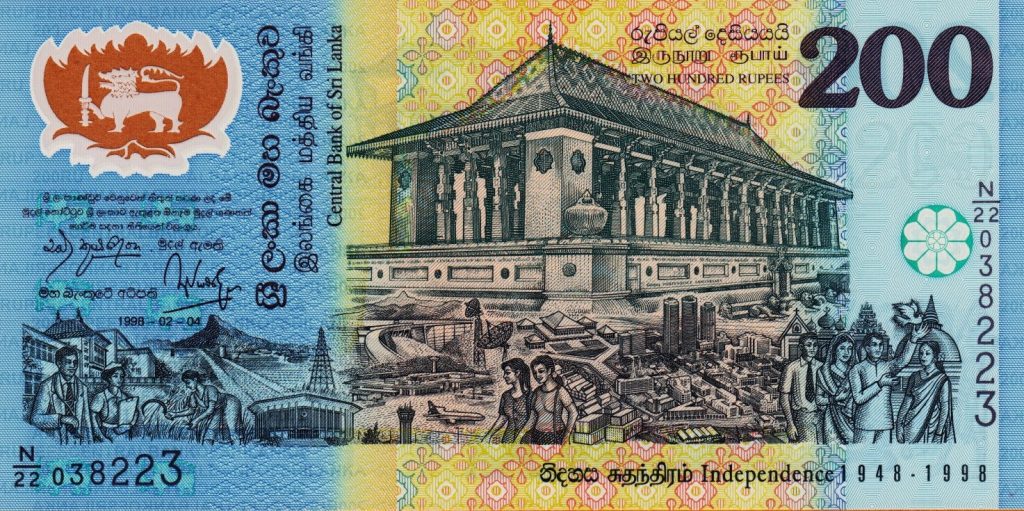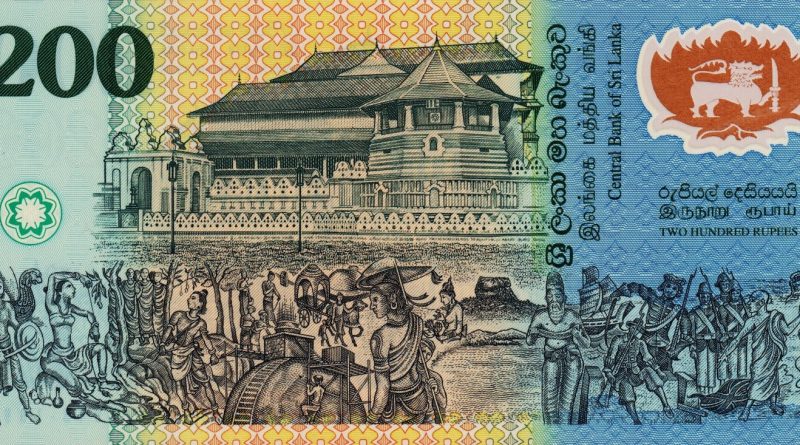The Central Bank of Sri Lanka issued a special 200-rupee commemorative banknote
In 1998, the Central Bank of Sri Lanka issued a special 200-rupee commemorative banknote to celebrate the 50th anniversary of Sri Lanka’s independence (1948-1998). This milestone marked five decades since Sri Lanka (formerly Ceylon) gained independence from British colonial rule on February 4, 1948.
This limited-edition banknote was introduced to commemorate the nation’s rich history, cultural heritage, and achievements over 50 years of self-rule. It stands out as one of the most symbolic and historically significant banknotes issued by Sri Lanka.
Overview of the Front and Back Note
The obverse (front) side of the banknote features the Temple of the Tooth Relic (Sri Dalada Maligawa) in Kandy, one of the most sacred Buddhist temples in Sri Lanka, which houses the relic of the tooth of Buddha. Below the temple, a detailed historical illustration depicts an ancient Sri Lankan royal court scene, showcasing cultural traditions and governance from the past.

The reverse (back) side of the banknote prominently displays the Independence Memorial Hall in Colombo, a landmark built to commemorate Sri Lanka’s independence. Surrounding the monument are historical scenes portraying Sri Lanka’s struggle for self-rule, along with traditional Sri Lankan motifs. The national emblem of Sri Lanka, featuring the lion holding a sword, is also present, reinforcing the nation’s sovereignty and pride.

Design Features
Obverse (Front)
- Temple of the Tooth Relic (Sri Dalada Maligawa) – Representing Sri Lanka’s deep-rooted Buddhist heritage and cultural identity.
- Illustration of an Ancient Royal Court – A tribute to Sri Lanka’s rich history, traditions, and governance from the past.
- Denomination “200 Rupees” – Printed clearly in both Sinhala and English.
- National Flag Emblem of Sri Lanka – A symbolic feature reinforcing Sri Lanka’s sovereignty and unity.
- Official Signature of the Governor of the Central Bank of Sri Lanka – Authenticating the issuance.
Reverse (Back)
- Independence Memorial Hall in Colombo – Symbolizing Sri Lanka’s liberation from colonial rule and national pride.
- Historical Depictions of Sri Lanka’s Independence Movement – Illustrating key moments leading to self-rule in 1948.
- Denomination “200 Rupees” – Clearly printed in multiple locations for easy recognition.
- National Emblem of Sri Lanka – Featuring the lion holding a sword, reinforcing the nation’s identity and strength.
Color Scheme
- The front side features a blend of blue, yellow, and green hues, reflecting Sri Lanka’s natural beauty and cultural vibrancy.
- The back side incorporates gold, orange, and purple tones, symbolizing the pride and prestige of the country’s independence.
The harmonious color palette enhances the note’s commemorative appeal, making it both visually striking and meaningful.
Dimensions
- Width: 157 mm
- Length: 79 mm
This size aligns with Sri Lanka’s standard banknote dimensions, ensuring that the note is easily recognizable and collectible.
Security Features
The 1998 “50th Anniversary of Independence” 200 Rupees Commemorative Banknote incorporates several advanced security features to prevent counterfeiting and ensure authenticity:
- Watermark – A hidden image of the lion emblem, visible when held against the light.
- Security Thread – A thin metallic strip embedded in the banknote, running vertically.
- Microprinting – Tiny text and details that can only be seen under magnification, preventing forgery.
- Raised Printing – Certain elements, such as the portrait and denomination, have a tactile texture, allowing authentication by touch.
- UV Features – Special patterns and serial numbers glow under ultraviolet light, confirming authenticity.
- Color-Shifting Ink – Some text and security patterns change color when viewed from different angles, enhancing protection.
- Intricate Border Designs – Inspired by Sri Lankan traditional motifs, adding an extra layer of security.
These modern security measures ensure that the note remains durable, difficult to counterfeit, and highly valuable for collectors.
Circulation and Collectibility
- This 200-rupee commemorative note was issued in limited quantities, making it a rare and valuable collector’s item.
- While it was legal tender, it was not widely circulated, as many people kept it as a souvenir of Sri Lanka’s 50 years of independence.
- The unique denomination (200 Rupees) was specifically chosen for this event, making it historically significant.
- Over time, its rarity and connection to Sri Lanka’s independence celebrations have increased its investment and sentimental value.
- Many copies exist in uncirculated condition, making them even more desirable among numismatists.


